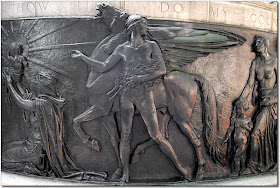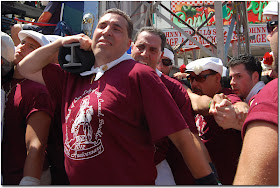 |
Mauro Giuliani
|
By Giovanni di Napoli
"Then Herr Mauro Giuliani, a Neapolitan, came to us—a man who had been led early in the right direction through correct sense of harmony, and who, as an accomplished virtuoso, combined with the most correct performance the greatest perfection of technique and of taste...Through his teaching and the competition he has aroused among teachers and lovers of the instrument, he has formed for us so many outstanding amateurs, that there could scarcely be another place where authentic guitar-playing is so widely practiced as here in our Vienna." —Excerpt from the preface to a guitar method published c.1811/12, entitled Versuch einer vollständigen methodischen Antleitung zum Guitare-Spielen by Simon Molitor and Wilhelm Klingenbrunner (1)
Southern Italy has a long history with the guitar, dating as far back as the Spanish viceroyalty. In fact, the earliest extant six-string guitar was built by the Neapolitan luthier Gaetano Vinaccia in 1779. The prestigious Gagliano, Fabricatore and Vinaccia families are credited with several innovations for the instrument and throughout the nineteenth century Naples remained a major center for its production. (2) It is also no coincidence that some of the most celebrated early classical guitarists—most notably the great Federico Moretti (1760-1838) and Ferdinando Carulli (1770-1841)—hailed from the Regno.
 However, when talking about the history of classical guitar in Southern Italy it is impossible not to mention Mauro Giuliani. For this we can thank music historian Thomas F. Heck and his major contributions to the field. This author's brief biographical sketch is completely indebted to Mr. Heck's illuminating Mauro Giuliani: Virtuoso Guitarist and Composer (Editions Orphée Inc., 1995) — the definitive work on Giuliani and a must-read for any serious student of the history of classical guitar.
However, when talking about the history of classical guitar in Southern Italy it is impossible not to mention Mauro Giuliani. For this we can thank music historian Thomas F. Heck and his major contributions to the field. This author's brief biographical sketch is completely indebted to Mr. Heck's illuminating Mauro Giuliani: Virtuoso Guitarist and Composer (Editions Orphée Inc., 1995) — the definitive work on Giuliani and a must-read for any serious student of the history of classical guitar. |
Mandolin (maple, spruce, tortoiseshell,
ivory), made by Vincenzo Vinaccia
(active 1769-1785), Naples, 1777
|
Sometime between 1801 and 1803 the young musician moved north to Trieste, presumably with his family (its possible they arrived at a later date). Generally, there are two schools of thought as to why they moved: The first was to escape the chaos caused by Napoleon's invasion of the Kingdom of Naples in 1799 and the second was the lack of opportunities to earn a living as a guitarist in a kingdom obsessed with opera. While both scenarios seam plausible, it was most likely a combination of the two—plus the limited number of publishing houses south of the Alps—that caused an exodus of guitarists from the kingdom.
In 1806 Giuliani took leave of his family and sought his fortune in Vienna, quickly acquiring a reputation as a remarkable composer and musician. He soon took on a mistress and in 1807 his illegitimate daughter, Maria Willmurth, was born. Its unclear if Giuliani was unfaithful to his wife or not, there are no records of her after Michel's birth, but we do know that he supported his daughter, even providing for her dowry.
 Nineteenth-century Imperial Vienna was a thriving musical center where musicians throughout the empire and beyond flocked to meet its musical demands. Receiving rave reviews from enthusiastic audiences, Giuliani established himself among the city's musical elite, which included such impressive luminaries as Johann Nepomuk Hummel and Ludwig van Beethoven. He taught, performed and published numerous compositions, making him the premier guitarist in Vienna.
Nineteenth-century Imperial Vienna was a thriving musical center where musicians throughout the empire and beyond flocked to meet its musical demands. Receiving rave reviews from enthusiastic audiences, Giuliani established himself among the city's musical elite, which included such impressive luminaries as Johann Nepomuk Hummel and Ludwig van Beethoven. He taught, performed and published numerous compositions, making him the premier guitarist in Vienna.
In 1808, at a time when the guitar was considered only suitable for song accompaniment, Giuliani had the audacity to premiere a three-movement concerto for guitar with full orchestra. While admitting that Giuliani was "perhaps the greatest guitarist who has ever lived" one critic from the influential music journal Allgemeine musikalische Zeitung could not grasp the guitar's evolving role as a solo instrument. According to the reporter, "One absolutely has to have heard the musician himself in order to get an idea of his unusual skill and his precise, tasteful execution," then backtracking, "We must put the guitar back in its place—let it stick to accompaniment—and we will always be happy to hear it." (4) The critic would go on and admonish the audience, claiming their excitement could only be explained as a fad.
Giuliani's third child, a daughter named Emilia, was born in Vienna in 1813. It is open to question who the mother was: Maria Giuseppa, Fräulein Willmurth or an unknown third woman? Whoever she was, they must have been married because the child bore his last name. Emilia would become famous in her own right as a guitar virtuoso, composing the famous set of preludes for guitar op.46.
On December 8, 1813 Giuliani played the cello at the première of Beethoven's Seventh Symphony.
His genius eventually caught the attention of Napoleon's second wife Empress Marie-Louise (later Duchess of Parma), who in 1814 bestowed on him the rank of "Honorary Chamber Virtuoso." According to Isnardi, the Empress also gave the composer/guitarist her own lyre-guitar, a magnificent instrument that combined the body of the lyre with the neck of a guitar.
In 1819 Giuliani joined Ludlams-Gesellschaft, a secret society founded by the city's artists and musicians. The Ludlamshöhle, as they were more commonly known, were more like a freewheeling fraternity than a subversive organization. As part of their affiliation members were given humorous nicknames—Giuliani was called Vilac Umo Capo d'astro. The capo d'astro part of his moniker clearly stems from his use of a little clamp on the neck of his guitar, but the Vilac Umo portion is less obvious. Some hypothesize that it’s a corruption of vigliacchi uomo, which in Italian means cowardly or dastardly man, a term of abuse Giuliani had a penchant of murmuring whenever he met someone he did not like.
Struggling to pay his debts (and possibly for health reasons), Giuliani returned to Italy. After visiting his parents in Trieste for almost three months he continued south towards Rome, taking a few detours along the way, including a short stay at Parma in order to pay his respects to his patroness Marie-Louise. In Rome, Giuliani continued publishing his works for the guitar and may have performed in concert with Rossini and Paganini. However, unable to firmly establish himself in the Eternal City he would try his luck in his homeland.
With its rich musical history and numerous theaters and salons, Naples vied with Vienna and Paris for the right to call itself Europe's music capital. Despite its importance in the production and development of the instrument, the quality of guitarists residing in Naples at the time inexplicably declined. In this favorable climate Giuliani had no trouble asserting his primacy.
Settling in the southern capital in 1823, Giuliani performed regularly for the Neapolitan nobility, quickly making a name for himself with his brilliant performances on the lyre-guitar. In 1824 his daughters, Maria and Emilia, were invited to stay with Marie-Louise, who was visiting relatives in Palermo. The Duchess was, after all, the daughter of Maria Theresa of Naples and Sicily.
In 1826 Giuliani had the great privilege of performing for King Francis I himself at the Palazzo Reale in Portici. Two years later, in what must have been a truly gratifying moment, he gave a concert with his daughter Emilia, who was only a teenager at the time. The performance was a great success, thus giving Emilia a promising start to her burgeoning career. Unfortunately, illness would keep Giuliani from performing with his daughter at her next recital.
Mauro Giuliani died in Naples on May 8, 1829; he was only 47-years-old. Highly prolific, he published over 200 compositions for the guitar. His extensive repertoire and inspirational performances, as well as the accomplishments of his many students, were undoubtedly a major factor in the future acceptance of the guitar as a solo instrument.
Giuliani was the most important guitarist of his time. His fame would live on long after his death:
"In his hands, the guitar became gifted with a power of expression at once pure, thrilling, and exquisite . . . In a word, he made the instrument sing." —Excerpt from Mauro Giuliani's eulogy printed in 1833 in Giulianiad, a guitar magazine named in his honor. (5)
To this day his work remains popular among classical guitarists and admirers of the genre alike.
The following source proved invaluable to this post:
• Mauro Giuliani: Virtuoso Guitarist and Composer by Thomas F. Heck, Editions Orphée Inc., 1995
Notes:
(1) Quoted from Mauro Giuliani: Virtuoso Guitarist and Composer by Thomas F. Heck, p. 32
(2) For more on the origins of the six-string guitar see "Stalking the Oldest Six-String Guitar" by Thomas F. Heck, 1972
(3) Quoted from Mauro Giuliani: Virtuoso Guitarist and Composer by Thomas F. Heck, p. 7
(4) Quoted from Mauro Giuliani: Virtuoso Guitarist and Composer by Thomas F. Heck, p. 39-40
(5) Quoted from Mauro Giuliani: Virtuoso Guitarist and Composer by Thomas F. Heck, p. 134
















































